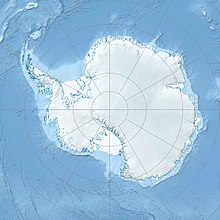Pobeda (iceberg)
Coordinates: 64 ° 39 ′ S , 98 ° 54 ′ E
Pobeda ( Russian Остров Победа Ostrow Popeda , German 'Sieg-Insel' , English Pobeda Ice Island 'Pobeda-Eisinsel' ) is a table iceberg that periodically rises off the coast of the East Antarctic Queen Marie Land or 160 km from the offshore Shackleton Ice shelf runs aground. The term island is geographically incorrect for this structure.
Periodic origin
Pobeda arises periodically and disappears again. It is created by the calving of the Denman Glacier east of the Shackleton Ice Shelf in the form of a tabular iceberg, which then drifts northwest and runs aground on an underwater bank . The iceberg is stuck there for a decade or more, until its thickness has decreased so much that it breaks away from the shallows and drifts further out into the open sea , where it eventually breaks apart and melts.
The floating glacier tongue of the Denman Glacier pushes through the flowing ice from the inland ice of East Antarctica into the sea until a new tabular iceberg of a similar size calves, which happens every 40 to 50 years.
A similar phenomenon was observed on the Thwaites Glacier on the Walgreen Coast in Marie Byrd Land .
Data
Pobeda is a tabular iceberg with almost vertical edges and an almost flat surface, which makes the designation as an island misleading. The object protrudes at least 27 meters from the sea.
Pobeda is up to 70 km long and 36 km wide, and covers an area of around 1500 km².
history
An iceberg was first sighted at the site in February 1840, by the United States Exploring Expedition led by Charles Wilkes . It blocked the way west along the Antarctic coast. That's why Wilkes named the object Termination Land .
Pobeda was found again in the years 1911 to 1913 by the first Australian Antarctic expedition under Douglas Mawson (and then called Termination Ice Tongue ), but no longer during the BANZARE expedition from 1929 to 1931, also led by Mawson .
The iceberg was back in 1960 when a Soviet expedition named it Pobeda Island. The Soviet Union maintained a weather station on Pobeda from May 9 to August 12, 1960 at a height of 27 meters above sea level, which was used to study the structure of the ice. This iceberg disappeared again in the 1970s.
In 1985 a new table iceberg calved, which existed until 2003 or 2004. According to the periodicity observed so far, a new formation can be expected around the year 2025 at the earliest.
Deep sea channel
About 200 km north of Podeba iceberg is a deep trough , the 1956 AP Lizitsin the name Pobeda trench (Engl. Pobeda Canyon ) received. It extends from 62 ° 30 ' S , 100 ° 15' O to 64 ° 30 ' S , 97 ° 35' O .
Web links
- Coordinates, station operating times, altitude
- Satellite map of the area
- Pobeda station
- Overview of maps
literature
- Bernard Stonehouse: Encyclopedia of Antarctica and the Southern Oceans . Wiley, Chichester / Hoboken 2002, ISBN 0-471-98665-8 , p. 200 [1]
